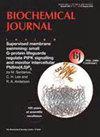Cell membrane asymmetries and cellular aging.
IF 4.3
3区 生物学
Q2 BIOCHEMISTRY & MOLECULAR BIOLOGY
引用次数: 0
Abstract
Saccharomyces cerevisiae, a widely studied unicellular eukaryotic model, multiplies and divides through an asymmetric budding process, where a mother cell produces a smaller daughter cell. Although cells age across successive cell divisions, provided the mother is not too old, each daughter cell inherits a full lifespan potential. Extensive studies in budding yeast have established a framework for understanding how asymmetric cell division contributes to this lifespan resetting. One postulate of this framework is that the capacity of mother cells to bud daughters with full replicative potential is critically dependent on membraneassociated mechanisms that enable asymmetric inheritance of aging factors. Despite the identification of numerous asymmetrically distributed proteins, an integrated catalog detailing their roles in aging has not been compiled. This review provides a comprehensive resource of asymmetrically distributed membrane proteins in yeast that have a role in replicative aging. Existing knowledge governing the establishment and maintenance of asymmetry is synthesized, and gaps in our understanding of how membrane asymmetry contributes to cellular aging are identified.细胞膜不对称与细胞老化。
酿酒酵母(Saccharomyces cerevisiae)是一种被广泛研究的单细胞真核生物模型,它通过不对称出芽过程繁殖和分裂,其中母细胞产生较小的子细胞。虽然细胞在连续的细胞分裂中会衰老,但只要母亲不是太老,每个子细胞都继承了完整的寿命潜力。对出芽酵母的广泛研究已经为理解不对称细胞分裂如何促进这种寿命重置建立了框架。该框架的一个假设是,母细胞孕育具有充分复制潜力的子细胞的能力严重依赖于膜相关机制,该机制使衰老因素的不对称遗传成为可能。尽管发现了许多不对称分布的蛋白质,但尚未编制出详细说明它们在衰老中的作用的综合目录。本文综述了酵母中不对称分布的膜蛋白在复制老化中的作用。现有的知识管理的建立和维持的不对称是综合的,并在我们的理解膜不对称如何促进细胞老化的空白被确定。
本文章由计算机程序翻译,如有差异,请以英文原文为准。
求助全文
约1分钟内获得全文
求助全文
来源期刊

Biochemical Journal
生物-生化与分子生物学
CiteScore
8.00
自引率
0.00%
发文量
255
审稿时长
1 months
期刊介绍:
Exploring the molecular mechanisms that underpin key biological processes, the Biochemical Journal is a leading bioscience journal publishing high-impact scientific research papers and reviews on the latest advances and new mechanistic concepts in the fields of biochemistry, cellular biosciences and molecular biology.
The Journal and its Editorial Board are committed to publishing work that provides a significant advance to current understanding or mechanistic insights; studies that go beyond observational work using in vitro and/or in vivo approaches are welcomed.
Painless publishing:
All papers undergo a rigorous peer review process; however, the Editorial Board is committed to ensuring that, if revisions are recommended, extra experiments not necessary to the paper will not be asked for.
Areas covered in the journal include:
Cell biology
Chemical biology
Energy processes
Gene expression and regulation
Mechanisms of disease
Metabolism
Molecular structure and function
Plant biology
Signalling
 求助内容:
求助内容: 应助结果提醒方式:
应助结果提醒方式:


